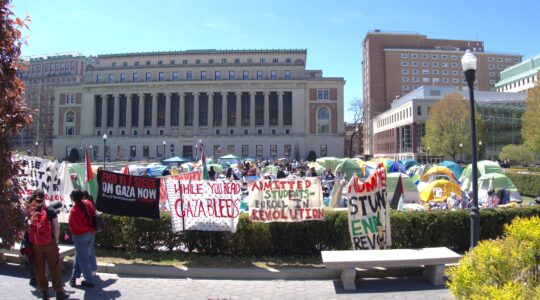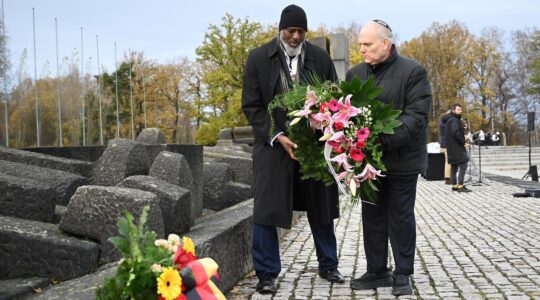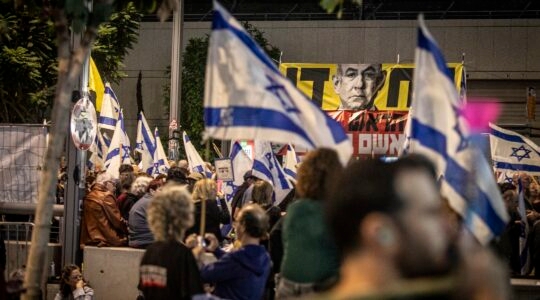NETZER HAZANI, Gaza Strip, Aug. 22 (JTA) — As they waited for the soldiers to carry out their orders to remove them from their home, the Yifrach family, with whom I had been staying for the past week in Netzer Hazani, brought out their only remaining furniture and sat on low stools outside their home, tears streaming down their faces. All I could think of was the resemblance to the shiva ritual. Netzer Hazani, along with 20 other communities in the Gaza Strip, has undergone a process during the pullout that can best be compared to the process of death and mourning. As a congregational rabbi, I realize that the emotions experienced by the 63 families in this moshav are similar to how families deal with a loved one diagnosed with a terminal illness. In the case of a sickness, as the end draws near an emotional conflict often develops within individuals and families between continuing to maintain hope of recovery and facing the reality that the end is near. In Netzer Hazani, until the end people prayed that the government decision would be overturned. Up until a few weeks ago, Mordechai and Aliza Yifrach were still working in their hothouse, planting, packing and sending their produce to Europe. But reality set in: Of the 48 families who decided to stay in their homes until they were physically evicted, many packed their belongings in anticipation of the inevitable. In the final stages, families have difficulty keeping in touch with reality. For Chaim Schneid, a patriarchal figure who came to Netzer Hazani 30 years ago as a young man and raised his family here, it came down to whether or not to uproot a tree he had planted in front of his house and move it to his new home. His son argued that the tree not be left for terrorists to enjoy. But Chaim’s view ultimately prevailed: The tree became a symbol of hope, and it will remain in front of the house to await the Schneids’ return to Netzer Hazani. On the final day, Amichai Yifrach, 24, approached the soldiers waiting to evict him from his home. Amichai, who had served as an EMT in the air force, lifted his shirt to reveal wounds he sustained when he was hit by shrapnel from a mortar that landed inside Netzer Hazani. “They tried to kill me,” he entreated. “Please don’t do this to us.” Then he dropped to the ground, wailing. When the soldiers marched into the community, images came to mind for an instant of foreign forces expelling Jews. It was, of course, a fleeting image: This was not a foreign army but a Jewish army, and the soldiers who entered Netzer Hazani comported themselves with great empathy throughout the operation. Three soldiers soon approached the Yifrach home. They respectfully asked for permission to enter and engage in conversation. As the soldiers explained that the time had come for the Yifrachs to leave, everyone sat together on the ground, almost as if at a shiva visit. Like all residents of the Gush Katif settlement bloc, Chaim Schneid and Aliza and Mordechai Yifrach relate to the land as a lover relates to his or her beloved. These are down-to-earth people who love Israel and the land in which they have personally invested so much of their physical and emotional energy. Now they feel as if they have lost their beloved. It was heart-wrenching to listen to the singing of Hatikva, Israel’s national anthem, as the Israeli flag was lowered before residents took final leave of their beloved community. Over to one side, Chaim Schneid was embracing his sons, all IDF officers, in a tearful but strong circle. On the other side, Binny Yefet, whose son Itamar was murdered on the road outside the community, stood stunned. After the flag was lowered, the entire crowd followed a Torah scroll dedicated to Rabbi Yitzhak Arama, 40, another Netzer Hazani victim of terror, as it was brought to the home of his widow and six children. In a piercing act, we then rent our garments like mourners at a funeral. What struck me so powerfully was how these dedicated people responded in such a holy way to a decree they felt was dangerous and which they felt came from a dishonest architect — dangerous because it sends a message that terrorism pays, and dishonest because Prime Minister Ariel Sharon ran on a platform opposing unilateral withdrawal and refused to allow a national referendum when he changed course. Notwithstanding such sentiments, the residents of Netzer Hazani responded with the highest sense of morality and with kedusha, or holiness. Our goal as Jews is to live lives of kedusha. Countless books have been written about what that means, but I learned more about how to conduct oneself in this manner from the people of Netzer Hazani than from any book. The media by and large ignored this behavior, focusing instead on the actions of a small number of provocative outsiders at the synagogues of Kfar Darom and Neveh Dekalim, two other Gaza settlements. It’s important not to taint the entire Gush Katif community with the brush of the extremists. Now the end has come. As in any mourning process, the people of Gush Katif will need time to grieve, feel the pain, sit shiva, and then pick up the pieces to try to move on. The challenge of death is to see to it that the person who has died continues to live on, and that we continue to be influenced by the legacy of the deceased. In a very real way, that was what was happening at the final moments of Gush Katif. Gal Levy, age six, expressed a similar idea in her carefully prepared sign that read, “If you believe it can be destroyed, you can also believe it will be rebuilt.” Anita and Stuart Tucker left a poignant message on their door: “Thirty years in Gush Katif: This melody will never cease.” All along the bus ride from Netzer Hazani to the Western Wall in Jerusalem, where the residents had decided to stay, pockets of people held up signs, “We are with you. We are one. Gush Katif forever.” Arriving at the kotel after 1 a.m, I was stunned to see thousands of people who had come to give the Netzer Hazani residents a hero’s welcome. Still, those who lined the road and greeted the residents were virtually all from the national religious community. Now there must be a coming together of those with the Gush Katif ideology with those living in Gush Dan, the central part of Israel, whose politics are very different. In the process of reclaiming the Land of Israel, energy must also be devoted to connecting to all of the people of the land. The disengagement from Gush Katif was a traumatic event. Healing is vitally necessary. But at the Western Wall, the predominant feeling among the people of Netzer Hazani was the hope that they would remain together as a community that would continue on elsewhere, and that the spirit of Netzer Hazani would remain forever. I looked up and saw Chaim Schneid surrounded by his family. Tears and smiles crossed their faces as they fervently sang melodies of loss and faith. Chaim Schneid’s farm and home were taken away, but no one can take away his family, or their resolve to continue.
JTA has documented Jewish history in real-time for over a century. Keep our journalism strong by joining us in supporting independent, award-winning reporting.






